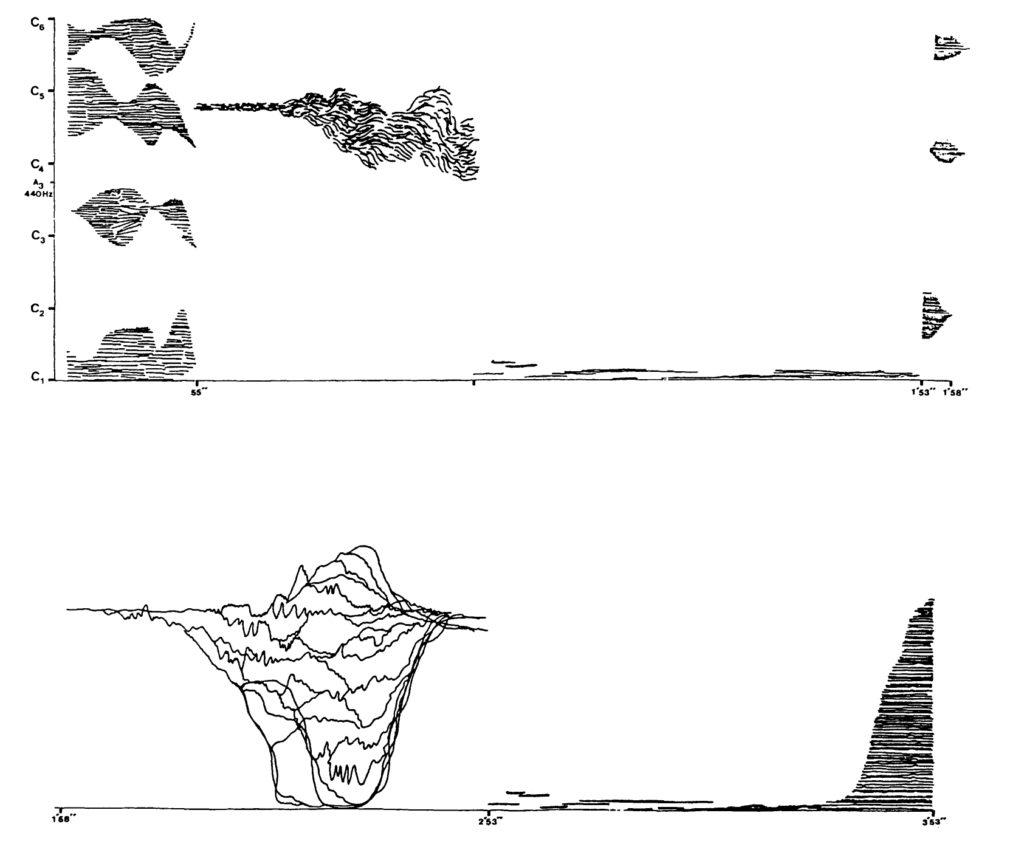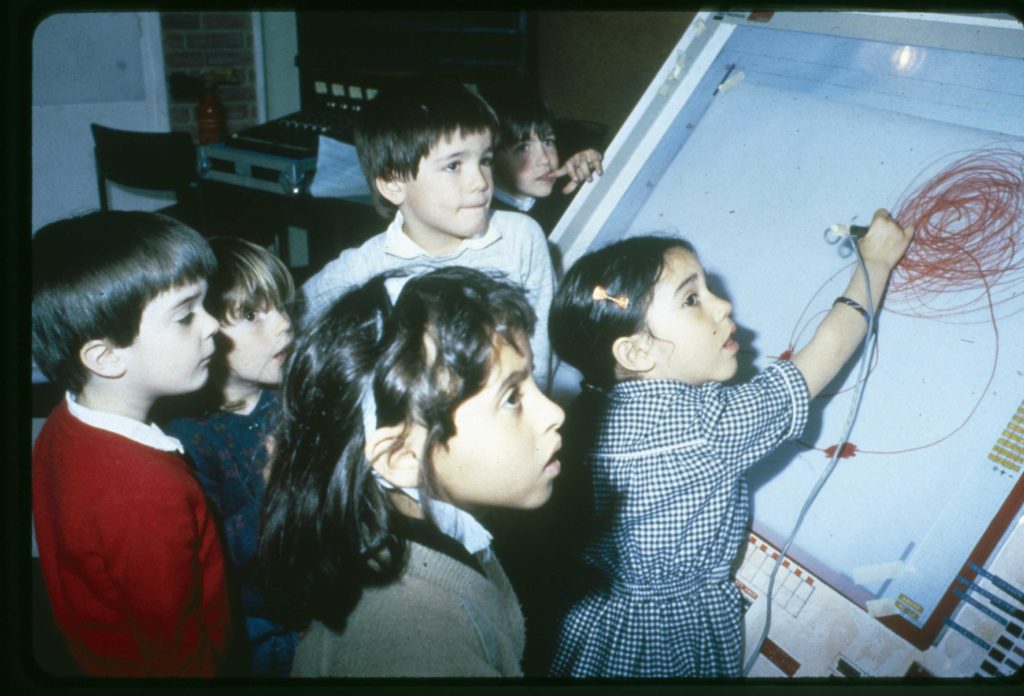The Engineer and Architect of Cyberpunk Cut-up Music: Iannis Xenakis’ Granular Synthesis
For media theorist Vilém Flusser, a “technical image” tells us more about models, computation, and calculation than it does about the world. It is less about representation; instead, it concerns the technological apparatus that makes the photo possible. I’d like to suggest a new category, “technical audio,” to discuss how denaturalizing recording technologies by “hacking them” may offer an entry point into discussing the relationships between cyberpunk and music. [1]
A staple of cyberpunk narrative is the mad technician: the rogue scientifically-minded, engineering-competent, coding mastermind making cyberspace possible. While cyberpunk literature owes its frenetic, fragmented energy to punk, hip-hop, MTV, and techno, the cut-up ethos found inspiration earlier in Burroughs and Gysin and stretches back to Tristan Tzara and Dada. Cut-up techniques are paradigmatically postmodern: not only as fragmented, multivocal alternatives to linearity and cohesion, but also as an art practice that merges the avant-garde with pop. Cyberpunk literature often blends the popular “punk” (guitars, bass, drums, and screams), with the technical “cyber” (turntables, samplers, synthesizers, tracking, and computers). There is, however, another musical trajectory that made the “cyber” element possible: the emergence of audio “cut-up” in the history of avant-garde electronic music. Today, I’ll focus on the stochastic music of Iannis Xenakis, the Greek engineer, architect, and composer who developed the electronic music equivalent to the cut-up in the 1950s: granular synthesis. I will then briefly wrap things up by discussing “technical audio” and its possible significance to cyberpunk culture.
Granular synthesis creates cut-ups of recorded audio. A recording is split into tiny clips (called grains) and then reassembled in a complex, nonlinear algorithmic sequence. While originally an analogue procedure,[2] this process would later be facilitated by Xenakis’ hypercomplex computer music. Xenakis’ “stochastic music” is named after “the branch of mathematics that studies the random or irregular activity of particles.”[3] For Xenakis, the effects of merging technology and music have a cyberpunk endgame: music, he writes, “must aim through fixations which are landmarks to draw towards a total exaltation in which the individual mingles, losing his consciousness in a truth immediate, rare, enormous, and perfect”;[4] that is, of technological transcendence and a recalibration of the nervous system as resistance to the neurototalitarian steering of techno-capitalism. Xenakis’ use of technology in music for transcendence and resistance can act as a reminder of the avant-garde lineage that informs so much cyberpunk culture though is often sidelined due to its incompatibility with the commodification practices that pressure much genre art. Granular synthesis is, in short, a means of creating sonic alternatives.

By 1977, Xenakis had developed a computerized “graphic notation” compositional tool called UPIC (Figure 1).[5]UPIC offered a shift away from traditional notation to graphic notation (Figure 2). Its graphic notation works by drawing shapes and contours on the computer; it then plays back hypercomplex music based on the “image.” These shapes could be mapped onto granular synthesis algorithms, and UPIC would “play” the contours back while also performing cut-ups to the sound in real-time. Granular synthesis prior to computerization was tedious: each “grain” would need to be physically cut from the tape and repositioned manually. Programs like UPIC automated this. The process also helps reveal something pressing about most access to music in the later 20th and early 21st century: we have endless access to audio “recordings.” By becoming more conscientious of the technological media that makes this possible, Xenakis’ project denaturalizes the relationship between music and the listening experience by drawing our attention to music’s technological mediation.

For Flusser, a technical image does something similar, though with an image rather than music. So, a photograph of a high rise or a digital photo of a landscape tells us very little about the reality of such objects. Rather representational crises, Flusser shifts his concern to crises of concept modeling. To interpret a technical image is to interpret the programs and apparatuses that made the image possible in the first place. For example, the photographer executes a program rather than intervenes in it: they “use” the mechanical, procedural, and processual functions of the camera to take a picture without intervening in the program that makes this activity possible.[6] Because technical images are executed, created, and developed using machines, Flusser’s concern is their underlying mechanical functions and mechanistic logic. In other words, the technology comes to also use the photographer. However, technical images permit us to trace “out opportunities for access and intervention”[7] into technology in ways that are unlike the unmediated ways we experience the world: satellite photographs, time-lapse photography, or microphotography can inform us about phenomena in ways inaccessible to the naked eye and therefore become extensions of our nervous system and physiology. Flusser asks us to look beyond what we see in these photos and, instead, invites us to consider how we see and act differently due to the technical image’s program. Flusser asks to not only take or look at a photo, but to critically hack the apparatus of photography.
Audio recordings, like photography, are technical. Whether cut to wax or vinyl, recorded on magnetic tape, or coded as digital audio, “technical audio” raises analogous questions about audio that the technical image does about photography. UPIC is not a high-fidelity machine, and granular synthesis creates sound unlike anything we could access without technology. Granular synthesis affects chronology, sequence, timbre, pitch, etc. We literally have a sound event, already recorded or generated, discombobulated, and fed back to us. When we hear granular synthesis, we immediately notice that what we’re hearing is impossible without intervening in technological apparatuses; we are also reminded what we hear on all recordings is technical. Just as Flusser’s technical image speaks to chemistry, math, and code rather than just “representation,” technical audio reminds us of the infinite possibilities that technology can do for music—but only if we engage with technology in non-habitual ways. Recorded music no longer solely represents a live performance so much as it urges us to hack recorded audio and aim for some kind of supermodern transcendence—note that recorded media is not bound by spatio-temporal linearity—through musical experiences that, without this tech, is impossible to experience.

Just as the Dadaists captured the process of random reassembling as resistance, the digital era of the 1980s onward demands engagement with the interfaces that govern the narratives of supermodern life. Granular synthesis aims to continue this resistance in the computer-era but, eschews postmodern pop in favour of a kind of supermodernist transcendence. The unpredictable rogue individualism of the Dadaists, beatniks, and punks, it should be noted, can today be easily modeled and predicted by Silicon Valley or Shenzhen in the 21st century. Xenakis’ granular synthesis, however, aims to resist this by engaging with a kind of music that creates a state of mind akin to stochastic agency, rather than individualism. If, for example, music is “pure expression” (as both Flusser and Xenakis hold) then hacking the technological apparatus of music production to produce “impossible” sonic textures characterized by their unpredictability and latent potentialities may enhance or accelerate pure expression against the algorithmic determinism characteristic of the early 21st century.
APPENDIX: SOUND RECORDINGS AND GRAPHIC SCORE USING UPIC
Mycenae Alpha (1978) – Iannis Xenakis
[1] This contribution is a largely rewritten excerpt from my book The Literature of Exclusion: Dada, Data, and the Threshold of Electronic Literature (forthcoming, Lexington Books, 2021). It appears in a chapter examining the “glitch aesthetics” of the cyberpunk avant-gardist and iconoclast Kenji Siratori. The concept of “technical audio” is unique to this paper.
[2] The two significant early pieces are titled Analogique A-B (1957-1958). Unfortunately, both pieces were recently removed from YouTube, so I cannot link to them here. However, they are generally not difficult to find at most public and institutional libraries.
[3] Alex Ross, The Rest is Noise: Listening to the Twentieth Century, (New York: Farrar, Straus and Giroux, 2007), 395.
[4] Iannis Xenakis, Formalized Music: Thought and Math in Composition, Revised Ed, (Stuyvesant, NY : Pendragon Press, 1992), 1.
[5] An abbreviation for Unité Polyagogique Informatique CEMAMu developed by Xenakis at the Centre d’Etudes de Mathématique et Automatique Musicales (CEMAMu) in Paris.
[6] Disruption of the standard practices in film and photography were also a central concern of Dadaists and surrealists in the early-twentieth-century. For more, see Candice Black’s Ghosts of the Black Chamber: Experimental, Dada & Surrealist Photography 1918-1948, (Solar Books, 2010).
[7] Roland Meyer, “Technical Images,” Flusseriana: An Intellectual Toolbox, Edited by Siegfried Zielinski, Peter Weibel, and Daniel Irrgang, (Univocal, 2015), 388.